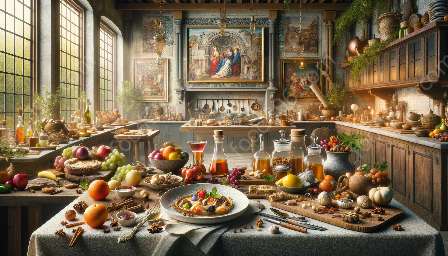The Renaissance period was a time of flourishing cultural, artistic, and intellectual development in Europe. The culinary landscape of this era was greatly influenced by the exploration and trade that expanded the availability of new ingredients and culinary techniques.
Trade and exploration played a significant role in shaping Renaissance cuisine, resulting in the incorporation of diverse flavors, spices, and cooking methods. The exchange of goods and ideas between different regions and continents created a melting pot of culinary traditions that transformed the way people approached food and dining.
Exploration and the Discovery of New Ingredients
During the Renaissance, European explorers embarked on voyages to distant lands, discovering and bringing back a wide array of previously unknown ingredients. The spice trade, in particular, played a crucial role in introducing new flavors to European cuisine. Spices such as cinnamon, pepper, cloves, and nutmeg, which were originally sourced from the Far East, found their way into the kitchens of Renaissance cooks.
The exploration of the Americas also led to the introduction of ingredients such as tomatoes, potatoes, corn, and chocolate to European cuisine. These newfound ingredients significantly enriched the culinary repertoire of Renaissance chefs, allowing them to experiment with a broader spectrum of flavors and ingredients.
Impact on Cooking Techniques and Culinary Practices
In addition to the introduction of new ingredients, the exchange of culinary practices and techniques during the Renaissance era brought about innovations in cooking methods. The fusion of different cooking styles and traditions gave rise to new recipes and culinary approaches that reflected a more cosmopolitan and diverse palate.
Cooks and food artisans became increasingly adventurous, incorporating foreign cooking techniques and adapting them to their local cuisines. The blending of culinary traditions resulted in the creation of unique dishes that intertwined the flavors of the East and the West.
Regional Influences and Culinary Diversity
The cultural exchange facilitated by trade and exploration also led to the assimilation of regional culinary traditions. As trade routes expanded, ingredients from various regions became more accessible, allowing for a fusion of culinary styles and flavors. Italian, French, Spanish, and Arabic culinary traditions, among others, influenced and enriched one another, giving rise to a rich tapestry of flavors and dishes.
Each region's unique produce and culinary expertise were celebrated and shared, contributing to the development of an increasingly diverse and sophisticated culinary landscape. The resulting fusion of flavors and techniques laid the foundation for the modern culinary paradigms we recognize today.
Legacy and Enduring Influence
The legacy of trade and exploration during the Renaissance era can still be seen in modern cuisine. The global exchange of ingredients and culinary knowledge continues to shape and enrich contemporary culinary practices, as chefs draw inspiration from a wide range of culinary traditions and ingredients.
Moreover, the spirit of culinary adventure and openness to new flavors that emerged during the Renaissance continues to define the ethos of contemporary gastronomy. The unique fusion of culinary traditions that arose from the exploration and trade of the Renaissance era continues to inspire chefs and food enthusiasts to push the boundaries of flavor and culinary creativity.
Conclusion
The role of trade and exploration in Renaissance cuisine was pivotal in shaping the culinary landscape of the time. The exchange of goods, ingredients, and culinary techniques facilitated a cross-pollination of flavors and traditions, giving rise to a diverse and vibrant culinary heritage that endures to this day. The exploration and trade routes of the Renaissance era laid the groundwork for the global culinary exchange that continues to define our culinary experiences today.

